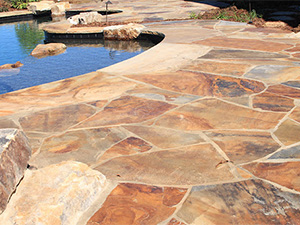
TENNESSEE CRAB ORCHARD STONE CARE TIPS
How to Maintain Your Tennessee Crab Orchard Stone
Image courtesy of Silvara Stone (www.silvarastone.com)
For property owners who have Tennessee Crab Orchard Stone, following these tips from the experts at Surface Care PROS will keep your stone looking its best, no matter the season, and of course, always feel free to reach out to us for any questions or support needs.
Crab Orchard Stone is a stunning natural sandstone known for its warm, rustic hues of tan, orange, and pink. Frequently used in patios, walkways, and outdoor walls, this versatile stone adds character to any space. However, like all natural stone, it requires regular maintenance to retain its beauty and durability over time.
Regular Cleaning
- Sweep Often – Use a broom or leaf blower to remove leaves, dirt, and debris.
- Rinse with Water – A quick spray from the garden hose helps keep the stone clean.
- Use Low Pressure Only – If you use a pressure washer, keep it under 1000 PSI and at least 12 inches away to avoid damage.
How to Clean It
- Choose the Right Cleaner – Use a pH-neutral cleaner made for natural stone. Avoid vinegar, bleach, or anything acidic—they can damage the surface.
- Tackle Stains Quickly:
- Rust stains: Use a rust-removing poultice safe for sandstone. Rust stains can be tough to deal with. Best to call your PRO.
- Mildew or leaf stains: A mix of hydrogen peroxide and water works well—test a small area first.
- Grease or oil: Use a degreasing cleaner made for stone.
- Seal the Stone if Appropriate – Consult with your stone PRO to determine if sealing is necessary for your specific environment. A high-quality penetrating sealer can help protect your Tennessee Crab Orchard Stone from stains and water penetration without altering its natural appearance. Penetrating sealers do not create a shiny or slippery surface but instead help the stone resist moisture absorption.
- Avoid Coatings or Glossy Sealers – These types of sealers are often inappropriate for natural stone, especially when the stone is in direct contact with the ground. They can trap moisture underneath the surface, which may lead to damage over time, including spalling (flaking) or cracking. Always consult your PRO to select the appropriate sealer.
- Reseal Every 2–3 Years – To maintain optimal protection, resealing may be necessary every 2 to 3 years, especially in climates with wet or freezing conditions. Be sure to check for any changes in the stone’s appearance, as this may indicate the need for resealing.
Winter & Freeze Protection
- Keep Water from Pooling – Make sure your patio or walkway drains well to avoid freezing damage.
- Don’t Use Salt or Ice Melt – These can harm the stone. Use sand or calcium magnesium acetate instead for traction.
Restoration Tips (When It Needs a Little Help)
- Stains Not Coming Out? – A poultice (stone-safe paste) can draw out deep stains. Contact us or refer to the Stain Management App under the Caring For It™ tab on our website.
- Stone Looks Worn? – Contact us. We can hone or clean it to bring back its original beauty.
- White Powdery Look? – That’s likely efflorescence from moisture. A stone-safe efflorescence cleaner can fix it or reach out to us to schedule service.
Final Tips
- Always test any cleaner or sealer in a small area first.
- When in doubt, ask your stone PRO—especially before using strong cleaners.
- Regular care keeps your Tennessee Crab Orchard Stone looking stunning for decades.
By Fred Hueston. This article is one of a series of Caring For It™ articles written and published on behalf of Surface Care PRO Partners.
